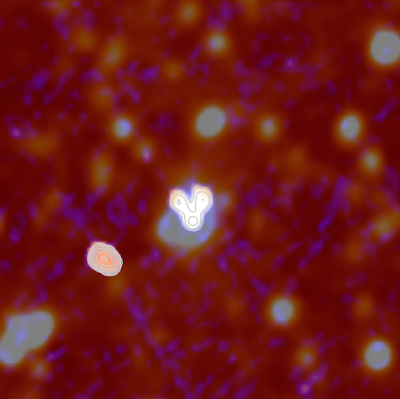The Radio Galaxy Zoo interface illustrating the three steps required to make a classification
(a) Step 1: select the radio
components that belong to a single radio source. (b) Step 2: select the
associated infrared galaxy that corresponds to the selected radio
source. (c) Step 3: either continue classifying the remaining radio
sources in the image or move on to the next subject. Hi-res image
A narrow-angled tail radio galaxy, where the bi-conical jets have been bent back somehow
A wide-angled tail radio galaxy from the Radio Galaxy Zoo project
This is a galaxy we refer to as the Mickey Mouse radio galaxy because it looks like a pair of MM ears from Disneyland! But we truly have no idea what this is at this point. Optical and radio images of Centaurus A reveal the complex morphology of the galaxy.
Trained volunteers are as good as professional astronomers at finding
jets shooting from massive black holes and matching them to their host
galaxies, research suggests.
Scientists working on citizen science project Radio Galaxy Zoo
developed an online tutorial to teach volunteers how to spot black holes
and other objects that emit large amounts of energy through radio
waves.
Through the project, volunteers are given telescope images taken in
both the radio and infrared part of the electromagnetic spectrum and
asked to compare the pictures and match the “radio source” to the galaxy
it lives in.
The results from the first year of the Radio Galaxy Zoo project, led
by Dr Julie Banfield of the ARC Centre of Excellence for All-Sky
Astrophysics and Dr Ivy Wong at the International Centre for Radio
Astronomy Research, were published today in the Monthly Notices of the
Royal Astronomical Society.
Before unleashing the eager crowd of online volunteers, the research
team tested the same 100 images on both the trained citizen scientists
and an expert team of ten professional astronomers.
“With this early study we’ve comfortably shown that anyone, once
we’ve trained them through our tutorial, are as good as our expert
panel,” Dr Banfield said.
“The volunteers have already ‘eyeballed’ more than 1.2 million radio
images from the Very Large Array in New Mexico and CSIRO’s Australia
Telescope Compact Array, and infrared images from NASA’s Spitzer and
WISE Space Telescopes."
In one year, the citizen scientists managed to match 60,000 radio
sources to their host galaxy—a feat that would have taken a single
astronomer working 40 hours a week roughly 50 years to complete.
“In the upcoming all-sky radio surveys, we are expecting 70 million
sources – 10 per cent of which will not be classifiable by any of the
computer algorithms currently available,” Dr Wong said.
"These 10 per cent will have weird and complex structures that need a
human brain to interpret and understand rather than a computer
program.”
"We have asked our volunteers to identify 170,000 radio sources that
are most likely to have unusual structures using current datasets, so we
are better prepared for what we could find in the upcoming next
generation radio surveys.”
At Radio Galaxy Zoo, professional astronomers talk to the
participants every day on a dedicated forum and often ask them to look
out for objects of interest.
“One member of the Radio Galaxy Zoo science team in Mexico loves
looking for ‘giants’—jets longer than a megaparsec, or about 125 times
the distance from Earth to the centre of the Milky Way. These are
typically very, very old radio jets,” Dr Wong said.
More Information
Dr Ivy Wong is based at the UWA node of the International centre for
Radio Astronomy Research (ICRAR), a joint venture between Curtin
University and The University of Western Australia with support and
funding from the State Government of Western Australia.
Dr Banfield is part of “The Evolving Universe” research theme of the
Australian Research Council Centre of Excellence for All-sky
Astrophysics (CAASTRO).
Radio Galaxy Zoo is an online project in which citizen scientists are helping scientists identify galaxies hosting jet-emitting massive black holes. See radio.galaxyzoo.org for more.
Original Publication Details
A‘Radio Galaxy Zoo: host galaxies and radio morphologies derived from visual inspection’ published in the Monthly Notices of the Royal Astronomical Society, Oxford University Press on 7/09/2015.
Available online at http://arxiv.org/abs/1507.07272.
Contact Details:
Dr Ivy Wong, ICRAR - UWA
Ph: +61 402 828 363 | E: Ivy.Wong@icrar.org
Dr Julie Banfield, ARC Centre of Excellence for All-Sky Astrophysics
Ph: +61 415 753 414 | E: Julie.Banfield@anu.edu.au
Pete Wheeler, ICRAR Media Contact
Ph: +61 423 982 018 | E: Pete.Wheeler@icrar.org
Dr Wiebke Ebeling, ARC Centre of Excellence for All-Sky Astrophysics
Ph: +61 423 933 444 | E: Wiebke.Ebeling@curtin.edu.au
David Stacey, UWA Media & Public Relations
Ph: +61 432 637 716 | E: David.Stacey@uwa.edu.au



